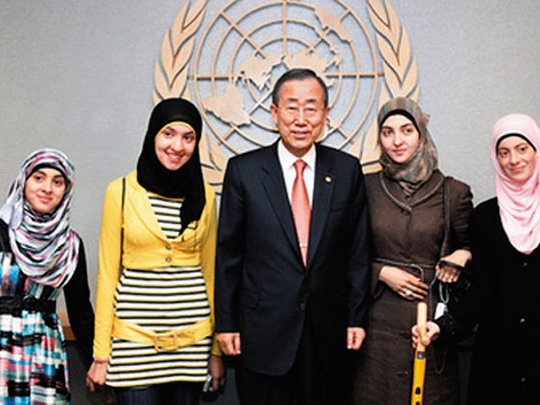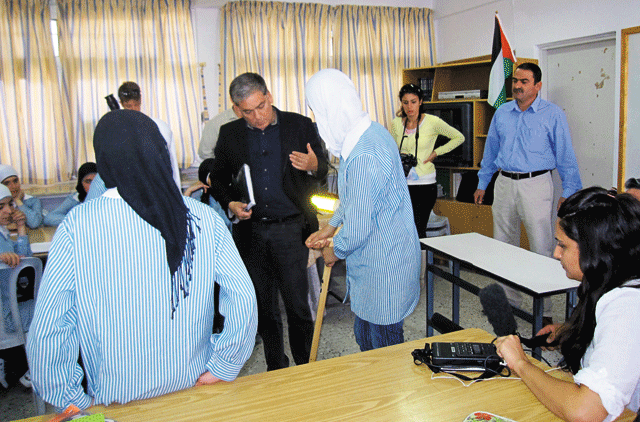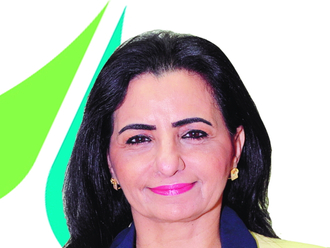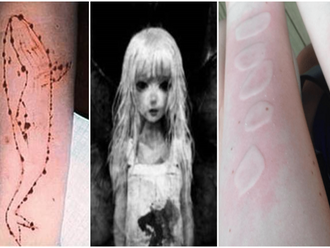
Where: Askar refugee camp, Nablus, West Bank
Who: Three 14-year old schools girls - Aseel Abu Leil, Nour Al-Arda and Aseel Shaer, from the Askar Basic Girls School.
Why: The violence had robbed the sight of many of their dear and near ones and the existing laser guided walking sticks were not serving the purpose.
It was an unforgettable day for three 14-year-old girls of the Askar Girl's School from Nablus, West Bank. Standing on the podium of the Intel Science Fair at San José, California, in May this year their hearts swelled with pride. They were part of a group of 1,500 students shortlisted from six million global aspirants who had applied to participate in the exhibition. Synaptics, an IT company that develops human interface solutions, was to present them witha special cash prize of $250 each for developing a laser cane that helps the visually challenged move around.
"Laser canes have been on the market since the Seventies, but the [one designed] by these girls resolves a fundamental flaw in previous models by detecting holes in the ground," said Mark Uslan, the director of the American Federation of the Blind Technology division. Unlike regular canes, this innovative beeping stick created by the girls has a sensor that alerts the user when it spots a hole or water on the ground. It even beeps if it finds the surface uneven.
Moved by suffering in the West Bank
For the girls - Aseel Abu Leil, Nour Al Arda and Aseel Sha'ar - who live in Nablus on the West Bank, accidents and mishaps are a way of life. The violence has claimed many lives and left many of their near and dear ones severely injured.
Thanks to the frequent blasts,the terrain itself is frequently riddled with debris and pockmarked with potholes, creating a nightmare for the visually handicapped.
For years, Sha'ar had watched her aunt and uncle, both of whom had lost their sight in an accident, navigate their way around their home.
The terrain around the Askar refugee camp run by the United Nations' Relief and Work Agency (UNRWA) in Nablus was extremely difficult to walk around and she noticed that the two would often miss their step and get hurt in the process.
Sha'ar was not the only one who wanted to do something to alleviate their plight. Her friends Al Arda and Abu Leil had also noticed how the visually challenged were havinga difficult time negotiating their way around the camp so, when their science teacher announced that the UNRWA (which ran many schools in the area) was coordinating an inter-school competition on scientific inventions, they knew what their class project for the competition would be.
They had no idea how they would raise the funds or procure the materials required to give shape to their dream but that did not stop the three from signing up for the competition. In an email interview with Friday, the three girls narrate how they went about inventing their prize-winning entry.
The right steps
"We had noticed that the visually impaired had difficulties moving around the camp," says Abu Leil. "So we began visualising a project that didn't have an overdose of theory but was practical and technically sound.''
Says Abu Leil, "We discussed the idea with our Camp Services Officer and the person in charge of the camp.'' Once the concept took shape, the girls began the groundwork.
"First, we conducted a survey among the visually-impaired in several non-governmental organisations as well as in Nablus and Ramallah region to study the feasibility of such an invention. The target groups we surveyed welcomed the idea and were keen we go ahead. The interviews also helped us gain feedback on the existing devices and where they were falling short. The Statistical Program for Social Sciences [a computer program] helped us interpret the results we obtained through our surveys.'' It was only after they were clear about the feasibility factor of a beeping stick that "we decided to go ahead".
Of course, the going was not easy. There were movement restrictions in and around the camp and resources were limited. The project also meant that the girls put in extra time at school creating a prototype, deciding on the raw materials and testing it.
Seeking raw materials, a challenge
"One of the first steps was assembling the material. Being novices, there were several trials and errors," recalls Al Arda. Initially they considered using aluminium but soon realised that it would mean creating a mould of certain specific dimensions. "That was working out to be quite expensive,'' she says. They then decided to see if wood would work. "We explained to the carpenter that we needed a hollow stick [so it would be light] with holes in certain specific areas. It took some time for him to get our idea, but after some trial and error we obtaineda stick that suited our plan," she says.
The next challenge they faced was finding the right kind of sensors that had to be incorporated into the cane.
Says Sha'ar, "We, along with our science teacher, searched the entire Nablus area, but with no success. Even the neighbouring Tulkarem area didn't have the resources for fitting the sensors. At one point we thought we might have to abandon the project asit was almost impossible to findthe sensors [we required]. After all,the sensors were the most important part of the concept! Finally, we travelled to Ramallah. Imagine our relief when we found several shops selling sensors there.''
However, they were in for another disappointment: the sensors available in the stores were not the kind the girls had in mind. "We could not locate the infrared sensors that we wanted to use in the stick. Finally, after a lot of running around, we found one shopkeeper who agreed to order those for us," says Sha'ar.
Once they secured the sensors, work on the cane progressed briskly and in no time the girls created the first prototype - a cane device with ground sensors to detect potholes. They entered this prototype in the inter-school competition which saw students from 97 schools putting up their inventions. However, the novel cane caught the judges' eyes, earning the team first place.
Aiming even higher
Refusing to rest on their laurels, the trio, encouraged by the recognition, decided to better the device. They returned to the drawing board keen to develop a cane for the visually handicapped that could be used even on stairs and uneven ground. They decided to add a reflector to the cane so drivers of vehicles could spot it at night. Not content, they also addeda set of vibrators to the cane so those who were deaf and blind could also use the innovative cane. A volume control knob was affixed to the handle of the cane so the user could adjust the volume of the audio sensors.
The handle itself was made in such a way that the cane would be held in the direction the user was facing. This ensured there would be no confusion from the signals picked up by the sensors. By the time the second prototype was complete, the girls' invention had become truly unique. Says Abu Leil: "The beeping canes available in the shops had a sensor that had a range of only 30cm and could not detect things in the dark. The sensors in our cane can pick up obstacles up to 80cm away.''
Once the sensor (which uses infrared waves) detects an obstacle, it triggers a device in the cane which makes a buzzing sound. Depending on the tone, the user can judge the position of the obstacle. According to the girls, their beeping cane is so successful that it is being used by people of all age groups.
How the device works
The device works on a rechargeable battery. "Children above six years of age and adults can use this cane. We have noticed though that men use it more willingly than women. Men have no issue walking with a cane in the street, whereas women prefer to hold onto a woman companion while moving around," says Sha'ar.
While the girls were happy when their invention won the first prize at the science competition in their local school, they were over the moon when they learnt that their entry had been selected for a global competition - the Intel Science fair which was held in May this year at San José.
"We never expected to be chosen for an international event,'' says Al Arda. "We were overwhelmed and very proud to represent Palestine at an international forum like a global-level science fair. We thought of it as an opportunity to let the world know that Palestinians in general and the refugee community in particular are very hard working and can be very ambitious and creative."
Ticket for two, but another setback
Even as they were preparing for the fair in California, a shock was awaiting the trio: According to the rules of the competition, only two people apart from their science teacher, Jameela Khalid, could go to California. Since all three had worked hard on the invention, it was not easy to drop one of them. They were left with only one option: a draw of lots. Sadly, Sha'ar lost out. It was truly a sad moment. She says, "I was very happy for my friends to be able to attend, and I knew they would represent the team to the best of their ability. The Public Information Office organised press coverage about our invention with international news channels like CNN and Reuters. The media people visited us in the class. We were seated together in a panel in front of our classmates, and had to talk live to the media on our invention. It was then that the UNRWA's spokesperson announced that UNRWA had pooled a fund from their international co-workers, and would be able to pay for the tickets of the third person as well! I was ecstatic, I actually cried on camera. I would be participating as an observer only (since the rules stipulated that the maximum number of participants should be 2, but I was thrilled anyway)."
The girls flew to California in May this year and were swept off their feet by the buzz of activity at the exhibition venue. They set up their stall and demonstrated their invention with elan.
"A panel of nine judges asked us questions about the project. They were interested in both the technical details and also the human dimension. We also took with us a video coverage of Saeed Kindeel, a visually impaired man from Nablus who demonstrated the efficacy of our cane by walking up and down the school stairs. The judges were quite impressed.
"The project was mentioned three times on the podium on various occasions, and received ample attention. When we received the special award form Synaptics we were overjoyed. Although we have not technically won the big prize, going to the US and meeting teams from across the world and building relations were a great experience for us," says Abu Leil.
Dreams for the future
The girls have since returned to their school and continue to have big dreams to achieve some distinction and serve their society.
Al Arda, who earlier wanted to be an electronics or IT engineer, has now shifted her focus and is keen to become an oncologist. Abu Leil wants to be a gynaecologist and professor in general medicine while Sha'ar wants to carry out research in genetics.
"We are thinking of improving the cane further but are looking for more funds. UNRWA is also assisting us in obtaining a copyright patent for this invention. We are also hoping thata local company would be able to adopt the project and help us take it to a higher level," says Nour.
Chris Gunness, spokesperson for the UNRWA describes these girls as the "Albert Einsteins of tomorrow".
"We need to teach the next generation rational thought, tothink through problems and talkabout problems. It's a microcosm of the peace process if you like, and we need to spend time and invest in education because that is the peace dividend of tomorrow."












